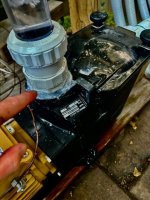- Jun 3, 2018
- 38
- Pool Size
- 20000
- Surface
- Vinyl
- Chlorine
- Salt Water Generator
- SWG Type
- Hayward Aqua Rite (T-15)
Hey I have a Hayward SP2670007x10. I drained some water off the pool thru waste, capped it back up, turned the pump back on but forgot to switch the valve it back to filter setting. Back pressure blew a threaded pipe off the pump (I’m not happy with myself). So I have some water seepage where I replaced the threaded connection, which was where the pipe leaves the pump chamber heading back to the filter. I think I’m also noticing some air blowing out around the pump, which I’ve never noticed before so I’m assuming it shouldn’t be doing that. I attached a picture pointing to the threaded black relief cap, I think the air is escaping around there but I’m not sure. Anyone have any thoughts on what I’m up against with this?



